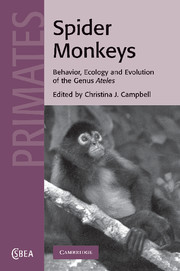Book contents
- Frontmatter
- Contents
- List of contributors
- Acknowledgements
- 1 Introduction
- Part I Taxonomy, phylogeny and evolution
- Part II Ecology
- Part III Behavior and reproduction
- 7 Locomotion and positional behavior of spider monkeys
- 8 Communication in spider monkeys: the function and mechanisms underlying the use of the whinny
- 9 Social interactions, social relationships and the social system of spider monkeys
- 10 Spider monkey reproduction and sexual behavior
- 11 Immaturity in spider monkeys: a risky business
- 12 Demography and group composition of Ateles
- Part IV Interactions with humans
- Index
- References
12 - Demography and group composition of Ateles
Published online by Cambridge University Press: 05 May 2010
- Frontmatter
- Contents
- List of contributors
- Acknowledgements
- 1 Introduction
- Part I Taxonomy, phylogeny and evolution
- Part II Ecology
- Part III Behavior and reproduction
- 7 Locomotion and positional behavior of spider monkeys
- 8 Communication in spider monkeys: the function and mechanisms underlying the use of the whinny
- 9 Social interactions, social relationships and the social system of spider monkeys
- 10 Spider monkey reproduction and sexual behavior
- 11 Immaturity in spider monkeys: a risky business
- 12 Demography and group composition of Ateles
- Part IV Interactions with humans
- Index
- References
Summary
Introduction
Spider monkeys are distributed widely throughout Central and South America and studies have been conducted at a variety of sites across the geographic range of the genus (see Table 1.1 in Campbell, this volume). However, detailed information about group composition and demography of spider monkeys remains largely unavailable. Because their fission–fusion social organization allows researchers to observe only a part of a group at any time, short-term surveys can rarely document overall group size and composition. Only a cumulative data set of party composition based on individual identification and longitudinal research can help determine the full composition of a group. Furthermore, the rarity of births and deaths make other demographic variables such as interbirth intervals only available through long-term investigation. In the 1980s, relevant demographic information from wild populations was available only for seven groups from five sites for three Ateles species. In this chapter, we present an updated summary of existing data on four Ateles species from 18 groups and 13 sites. We analyze both previously published and new data from these sites and compare them in order to re-examine the demographic characteristics of spider monkey groups.
Methods
Demographic data from 18 groups and 13 sites (Table 12.1) were gathered from the literature and augmented with data from a questionnaire sent to spider monkey researchers in 2005.
- Type
- Chapter
- Information
- Spider MonkeysThe Biology, Behavior and Ecology of the Genus Ateles, pp. 329 - 348Publisher: Cambridge University PressPrint publication year: 2008
References
- 41
- Cited by



